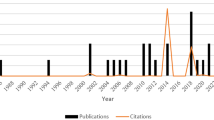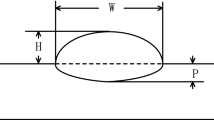Abstract
Currently, competitive markets place a great emphasis on various quality characteristics to customers. In the past, competition on the manufacturing of the bearing outer rings has primarily focused on the product hardness. Other quality characteristics of stain yield and roundness performance have recently become equally critical to fulfill customer satisfaction. To simultaneously meet all requirement criteria, the multiple response surface optimisation has focused on the use of desirability function approach to combine multiple response criteria into a single performance measure and to determine the optimal process design parameters of a pre-heat and heat chamber heaters, number of vacuum, gas fan speed in quenching chamber and partial gas pressure. This study proposed integrated algorithms with Taguchi orthogonal design and analysis and desirability function approach in forms of the path of composite ascent. There are three phases which use the conventional aspect of the steepest ascent via influential parameters, designed for moving toward the optiumum, use the ant colony optimisation (ACO) and hunting search (HuS) mechanism to present getting stuck at the local optimum. Results demonstrate that the integrated algorithms with the ACO and HuS elements are superior to the use of conventional composite ascent algorithm on average of 15.11 and 16.43 % improvement, respectively, for the overall responses. The confirmation tests on the actual manufacturing process based on the predicted operating conditions were verified and carried out to show statistically significant improvement at 95 % confidence interval.








Similar content being viewed by others
References
Al-Refaie, A., & Al-Tahat, M. D. (2011). Solving the multi-response problem in Taguchi method by benevolent formulation in DEA. Journal of Intelligent Manufacturing, 22, 505–521. doi:10.1007/s10845-009-0312-8.
Arnaout, J. P., Rabadi, G., & Musa, R. (2010). A two-stage ant colony optimisation algorithm to minimise the makespan on unrelated parallel machines with sequence-dependent setup times. Journal of Intelligent Manufacturing, 21, 693–701. doi:10.1007/s10845-009-0246-1.
Arnaout, J. P. (2013). Ant colony optimisation algorithm for the Euclidean location-allocation problem with unknown number of facilities. Journal of Intelligent Manufacturing, 24(1), 45–54.
Carlos, A. C. C., & Ricardo, L. B. (2009). Evolutionary multiobjective optimisation in materials science and engineering. Materials and Manufacturing Processes, 24, 119–129.
Chang, C., Yang, J., Chi, L., & Chou, C. (2010). Optimisation of heat treatment parameters with the Taguchi method for the A7050 aluminum alloy. Advanced Materials Research, 139–141, 157–162.
Chen, Z. C., & Fu, Q. (2007). A practical approach to generating steepest ascent tool-paths for three-axis finish milling of compound NURBS surfaces. Computer-Aided Design, 39, 964–974.
Dorigo, M., & Blum, C. (2005). Ant colony optimisation theory: A survey, theoretical. Computer Science, 344, 243–278.
Edwards, D. J., & Fuerte, J. N. (2011). Compromise ascent directions for multiple-response applications. Quality and Reliability Engineering International, 27, 1107–1118. doi:10.1002/qre.1199.
Fan, S. K. S., & Huang, K. N. (2011). A new search procedure of steepest ascent in response surface exploration. Journal of Statistical Computation and Simulation, 81, 661–678.
Gijo, E. V., & Scaria, J. (2012). Product design by application of Taguchi’s robust engineering using computer simulation. International Journal of Computer Integrated Manufacturing, 25(9), 761–773.
Hong, C. W. (2012). Using the Taguchi method for effective market segmentation. Expert Systems with Applications, 39, 5451–5459.
Hsiang, S. H., Lin, Y. W., & Lai, J. W. (2012). Application of fuzzy-based Taguchi method to the optimisation of extrusion of magnesium alloy bicycle carriers. Journal of Intelligent Manufacturing, 23(3), 629–638.
Hsieh, K. L., Tong, L. I., Chiu, H. P., & Yeh, H. Y. (2005). Optimisation of a multi-response problem in Taguchi’s dynamic system. Computers and Industrial Engineering, 49, 556–571.
Jeong, I. J., & Kim, K. J. (2009). Stochastics and statistics: An interactive desirability function method to multiresponse optimisation. European Journal of Operational Research, 195, 412–426. doi:10.1016/j.ejor.2008.02.018.
Kamyabi-Gol, A., & Sheikh-Amiri, M. (2010). Spheroidising kinetics and optimisation of heat treatment parameters in CK60 steel using Taguchi robust design. Journal of Iron and Steel Research International, 17(4), 45–52.
Kumar, R., & Allada, V. (2007). Scalable platforms using ant colony optimisation. Journal of Intelligent Manufacturing, 18, 127–142. doi:10.1007/s10845-007-0009-9.
Kumar, V. V., Pandey, M. K., Tiwari, M. K., & Arieh, D. B. (2010). Simultaneous optimisation of parts and operations sequences in SSMS: A chaos embedded Taguchi particle swarm optimisation approach. Journal of Intelligent Manufacturing, 21, 335–353. doi:10.1007/s10845-008-0175-4.
Lee, S. M., Kim, B. H., Shin, J. S., & Moon, B. M. (2007). Optimisation of heat treatment parameters of Mo-free high-Cr cast iron mill balls. Advanced Materials Research, 24–25, 913–916.
Leisk, G., & Saigal, A. (1992). A statistical approach to the heat treatment optimization of Al-Al2O3 particulate composites. Journal of Materials Engineering and Performance, 1(1), 45–48.
Leisk, G., & Saigal, A. (1995). Taguchi analysis of heat treatment variables on the mechanical behavior of alumina/aluminum metal matrix composites. Composites Engineering, 5(2), 129–142.
Lin, H. L. (2012a). Optimising the auto-brazing process quality of aluminum pipe and flange via a Taguchi-Neural-Genetic approach. Journal of Intelligent Manufacturing, 23(3), 679–686.
Lin, H. L. (2012b). The use of the Taguchi method with grey relational analysis and a neural network to optimize a novel GMA welding process. Journal of Intelligent Manufacturing, 23(5), 1671–1680.
Liu, X. J., Yi, H., & Ni, Z. H. (2010). Application of ant colony optimisation algorithm in process planning optimisation. Journal of Intelligent Manufacturing, 24(1), 1–13. doi:10.1007/s10845-010-0407-2.
Mizobe1, K., Santos, E. C., Honda, T., Koike, H., Kida, K., & Shibukawa, K. (2012). Observation of non-metallic inclusions on repeatedly quenched SAE 52100 bearing steel fracture surfaces. Journal International Journal of Materials and Product Technology, 44, 227–239. doi:10.1504/IJMPT.2012.050186.
Movahedi, M., Kokabi, A. H., & Seyed Reihani, S. M. (2011). Investigation on the bond strength of Al-1100/St-12 roll bonded sheets, optimisation and characterisation. Materials and Design, 32(6), 3143–3149.
Oftadeh, R., Mahjoob, M. J., & Shariatpanahi, M. (2010). A novel meta-heuristic optimisation algorithm inspired by group hunting of animals: Hunting search. Computers and Mathematics with Applications, 60, 2087–2098.
Pandey, A. K., & Dubey, A. K. (2012). Taguchi based fuzzy logic optimisation of multiple quality characteristics in laser cutting of duralumin sheet. Optics and Lasers in Engineering, 50, 328–335.
Pontes, F. J., Paiva, A. P., Balestrassi, P. P., Ferreira, J. R., & Silva, M. B. (2012). Optimisation of radial basis function neural network employed for prediction of surface roughness in hard turning process using Taguchi’s orthogonal arrays. Expert Systems with Applications, 39, 7776–7787.
Samrout, M., Kouta, R., Yalaoui, F., Châtelet, E., & Chebbo, N. (2007). Parameter’s setting of the ant colony algorithm applied in preventive maintenance optimisation. Journal of Intelligent Manufacturing, 18(6), 663–677.
Sibalija, T. V., & Majstorovic, V. D. (2012). An integrated approach to optimise parameter design of multi-response processes based on Taguchi method and artificial intelligence. Journal of Intelligent Manufacturing, 23, 1511–1528. doi:10.1007/s10845-010-0451-y.
Singh, A., Datta, S., Mahapatra, S. S., Singha, T., & Majumdar, G. (2013). Optimisation of bead geometry of submerged arc weld using fuzzy based desirability function approach. Journal of Intelligent Manufacturing, 4(1), 35–44. doi:10.1007/s10845-011-0535-3.
Soveja, A., Cicala, E., Grevey, D., & Jouvard, J. M. (2008). Optimisation of TA6V alloy surface laser texturing using an experimental design approach. Optics and Lasers in Engineering, 46, 671–678.
Tsai, P. W., Pan, J. S., Chen, S. M., & Liao, B. Y. (2012). Enhanced parallel cat swarm optimisation based on the Taguchi method. Expert Systems with Applications, 39, 6309–6319.
Wang, L., Tang, D. B., Gu, W. B., Zheng, K., Yuan, W. D., & Tang, D. S. (2012). Pheromone-based coordination for manufacturing system control. Journal of Intelligent Manufacturing, 23(3), 747–757.
Acknowledgments
This work was supported by the National Research University Project of Thailand Office of Higher Education Commission. The author wishes to thank the Faculty of Engineering, Thammasat University, THAILAND and Mr. Korakoch WAIYAKAN for the early phase of this research.
Author information
Authors and Affiliations
Corresponding author
Rights and permissions
About this article
Cite this article
Luangpaiboon, P. Evolutionary elements on composite ascent algorithm for multiple response surface optimisation. J Intell Manuf 26, 539–552 (2015). https://doi.org/10.1007/s10845-013-0813-3
Received:
Accepted:
Published:
Issue Date:
DOI: https://doi.org/10.1007/s10845-013-0813-3




